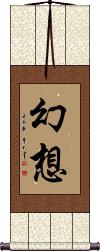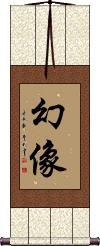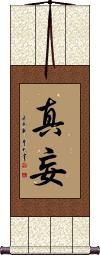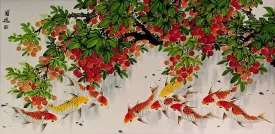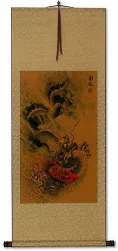Many custom options...
And formats...

Not what you want?
Try other similar-meaning words, fewer words, or just one word.
Fantasy Illusion in Chinese / Japanese...
Buy a Fantasy Illusion calligraphy wall scroll here!
Personalize your custom “Fantasy Illusion” project by clicking the button next to your favorite “Fantasy Illusion” title below...
Fantasy / Illusion
幻想 is illusions or fantasy in Chinese, Japanese Kanji, and old Korean Hanja.
This can also refer to delusion or daydreaming. It sort of means a dream or idea that cannot be true or real ( at least not in this realm).
Flower in the Mirror, Moon on Water
鏡花水月 is an old Asian proverb that means “flowers in a mirror and the moon reflected in the lake” or “flowers reflected on a mirror and the moon reflected on the water's surface.”
Literally, 鏡花水月 reads “Mirror Flower, Water Moon.”
Figuratively this can be used to represent a lot of different ideas. It can be used to express an unrealistic rosy view or viewing things through rose-tinted spectacles. So you can use it to relay an idea about something that is visible but has no substance,
something that can be seen but not touched, or something beautiful but unattainable such as dreams or a mirage.
This expression is used to describe things like the subtle and profound beauty of poems that cannot be described in words.
鏡 = Mirror (or lens)
花 = Flower(s)
水 = Water
月 = Moon
Can also be written 水月鏡花 (just a slight change in word/character order).
Illusion
幻像 is a universal word for Illusion in Chinese, Japanese Kanji, and old Korean Hanja.
The first character means phantasm, vision, dream, illusion, apparition, or fantasy.
The second character means statue, picture, image, figure, portrait, shape, form, appearance, to be like, to resemble, to take after, to seem, or in rare/ancient context: an elephant.
![]() Note that the first character can be written without the left-side radical in Chinese. This form is shown to the right. Both forms are acceptable in Chinese but the character shown to the right is more likely to be read as "elephant."
Note that the first character can be written without the left-side radical in Chinese. This form is shown to the right. Both forms are acceptable in Chinese but the character shown to the right is more likely to be read as "elephant."
See Also: Reality
Reality and Illusion
Buddhism Concept
This in-stock artwork might be what you are looking for, and ships right away...
Gallery Price: $120.00
Your Price: $49.88
Gallery Price: $65.00
Your Price: $35.88
Gallery Price: $450.00
Your Price: $248.88
Gallery Price: $240.00
Your Price: $138.88
Not the results for Fantasy Illusion that you were looking for?
Below are some entries from our dictionary that may match your Fantasy Illusion search...
| Characters If shown, 2nd row is Simp. Chinese |
Pronunciation Romanization |
Simple Dictionary Definition |
幻想 see styles |
huàn xiǎng huan4 xiang3 huan hsiang gensou / genso げんそう |
More info & calligraphy: Fantasy / Illusion(noun, transitive verb) fantasy; illusion; vision; dream |
幻 see styles |
huàn huan4 huan maboroshi まぼろし |
fantasy (noun - becomes adjective with の) (1) phantom; vision; illusion; apparition; (noun - becomes adjective with の) (2) something fleeting; short-lived dream; (noun - becomes adjective with の) (3) fabled item; mythical thing; very rare thing; (surname) Maboroshi māyā. Illusion, hallucination, a conjurer's trick, jugglery, i. e. one of the ten illustrations of unreality. |
做夢 做梦 see styles |
zuò mèng zuo4 meng4 tso meng |
to dream; to have a dream; fig. illusion; fantasy; pipe dream |
夢幻 梦幻 see styles |
mèng huàn meng4 huan4 meng huan mugen むげん |
dream; illusion; reverie dreams; fantasy; visions; (personal name) Mugen Dream and illusion, the characteristics of all phenomena. |
幻夢 幻梦 see styles |
huàn mèng huan4 meng4 huan meng genmu げんむ |
fantasy; illusion; dream dreams; visions; phantasms illusion and a dream |
狂想 see styles |
kuáng xiǎng kuang2 xiang3 k`uang hsiang kuang hsiang kyousou / kyoso きょうそう |
fantasy; illusion; vain dream whimsical thoughts; rambling ideas; irrational ideas |
空幻 see styles |
kōng huàn kong1 huan4 k`ung huan kung huan |
vanity; empty fantasy; illusion |
幻を追う see styles |
maboroshioou / maboroshioo まぼろしをおう |
(exp,v5u) to pursue an illusion; to pursue a fantasy; to pursue phantoms |
The following table may be helpful for those studying Chinese or Japanese...
| Title | Characters | Romaji (Romanized Japanese) | Various forms of Romanized Chinese | |
| Fantasy Illusion | 幻想 | gensou / genso | huàn xiǎng huan4 xiang3 huan xiang huanxiang | huan hsiang huanhsiang |
| Flower in the Mirror, Moon on Water | 鏡花水月 镜花水月 | kyou ka sui getsu kyoukasuigetsu kyo ka sui getsu | jìng huā shuǐ yuè jing4 hua1 shui3 yue4 jing hua shui yue jinghuashuiyue | ching hua shui yüeh chinghuashuiyüeh |
| Illusion | 幻像 幻像 / 幻象 | gen zou / genzou / gen zo | huàn xiàng huan4 xiang4 huan xiang huanxiang | huan hsiang huanhsiang |
| Reality and Illusion | 真妄 | zhēn wàng zhen1 wang4 zhen wang zhenwang | chen wang chenwang |
|
| In some entries above you will see that characters have different versions above and below a line. In these cases, the characters above the line are Traditional Chinese, while the ones below are Simplified Chinese. | ||||
Successful Chinese Character and Japanese Kanji calligraphy searches within the last few hours...
